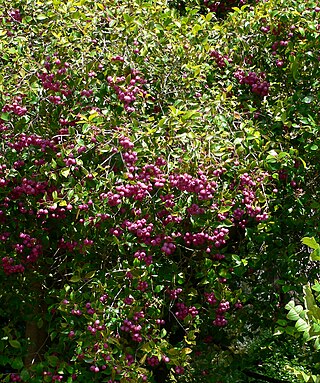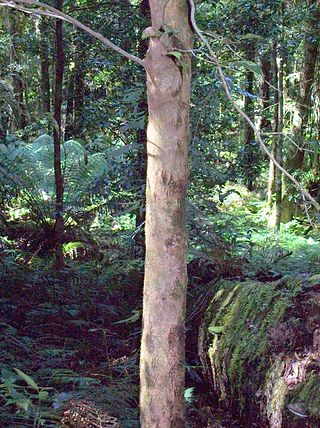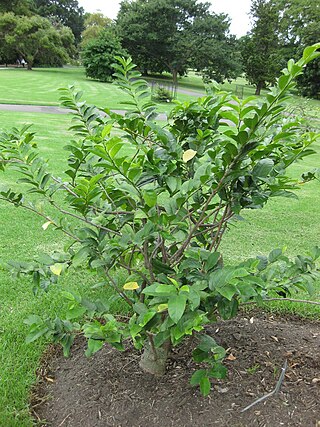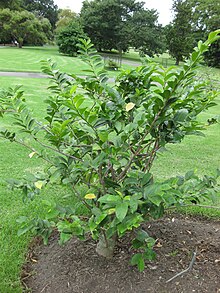
Breadfruit is a species of flowering tree in the mulberry and jackfruit family (Moraceae) believed to be a domesticated descendant of Artocarpus camansi originating in New Guinea, the Maluku Islands, and the Philippines. It was initially spread to Oceania via the Austronesian expansion. It was further spread to other tropical regions of the world during the Colonial Era. British and French navigators introduced a few Polynesian seedless varieties to Caribbean islands during the late 18th century. Today it is grown in some 90 countries throughout South and Southeast Asia, the Pacific Ocean, the Caribbean, Central America and Africa. Its name is derived from the texture of the moderately ripe fruit when cooked, similar to freshly baked bread and having a potato-like flavor.

Euphorbia is a very large and diverse genus of flowering plants, commonly called spurge, in the family Euphorbiaceae. "Euphorbia" is sometimes used in ordinary English to collectively refer to all members of Euphorbiaceae, not just to members of the genus.

Aeonium, the tree houseleeks, is a genus of about 35 species of succulent, subtropical plants of the family Crassulaceae. Many species are popular in horticulture. The genus name comes from the ancient Greek αἰώνιος / aiōnios (ageless). While most of them are native to the Canary Islands, some are found in Madeira, Cape Verde, Morocco, in East Africa and Yemen.

Tecoma is a genus of seven species of shrubs or small trees in the trumpet vine family, Bignoniaceae. They are native to the Americas, ranging from the extreme southern United States through Central America and the Antilles south through Andean South America to northern Argentina. The generic name is derived from the Nahuatl word tecomaxochitl, which was applied by the indigenous peoples of Mexico to plants with tubular flowers. Trumpetbush is a common name for plants in this genus.

Syzygium smithii is a summer-flowering, winter-fruiting evergreen tree, native to Australia and belonging to the myrtle family Myrtaceae. It shares the common name "lilly pilly" with several other plants.It is planted as shrubs or hedgerows, and features: rough, woody bark; cream and green smooth, waxy leaves; flushes of pink new growth; and white to maroon edible berries. Unpruned, it will grow about 3–5 m (9.8–16.4 ft) tall in the garden.

Acmena was formerly the name of a genus of shrubs and trees in the myrtle family Myrtaceae. The genus was first formally described in 1828 by Augustin Pyramus de Candolle in his Prodromus Systematis Naturalis Regni Vegetabilis.

The hybrid elm cultivar Ulmus × hollandica 'Smithii', commonly known as the Downton Elm, was one of a number of cultivars arising from the crossing of the Wych Elm U. glabra with the Field Elm U. minor. The tree was originally planted at Downton Castle near Ludlow, as one of a batch, not all of them pendulous in habit, raised at Smith's Nursery, Worcester, England, from seeds obtained from a tree in Nottingham in 1810.
Durio wyatt-smithii is a species of flowering plant in the family Malvaceae. It is a tree endemic to Peninsular Malaysia.

Streblus is a genus of flowering plants in the mulberry family, Moraceae. It includes five species native to the Indian subcontinent, Indochina, southern China, and Malesia.

Eucalyptus smithii, commonly known as the gully gum, gully peppermint, blackbutt peppermint, or ironbark peppermint, is a species of medium-sized to tall tree, sometimes a mallee, that is endemic to southeastern Australia. It has rough, compact bark on the trunk, smooth ribbony bark above, narrow lance-shaped adult leaves, flower buds in groups of seven, white flowers and cup-shaped, bell-shaped or hemispherical fruit.

Zieria smithii, commonly known as sandfly zieria, lanoline bush or Smithian zieria, is a plant in the citrus family Rutaceae and is endemic to eastern and south-eastern Australia. It is a robust shrub with its leaves composed of three leaflets, and groups of flowers with four white petals, the groups usually shorter than the leaves. It is common and widespread along the coast and adjacent ranges.

Paratrophis pendulina is a species of flowering plant in the mulberry family, Moraceae. In Australia it is commonly known as whalebone tree, and other common names include the white handlewood, axe-handle wood, grey handlewood and prickly fig. In Hawaii it is known as Hawai'i roughbush or aʻiaʻi in Hawaiian.

A plant community is a collection or association of plant species within a designated geographical unit, which forms a relatively uniform patch, distinguishable from neighboring patches of different vegetation types. The components of each plant community are influenced by soil type, topography, climate and human disturbance. In many cases there are several soil types present within a given plant community. This is because the soil type within an area is influenced by two factors, the rate at which water infiltrates or exits the soil, as well as the rate at which organic matter enters or decays from the soil. Plant communities are studied substantially by ecologists, due to providing information on the effects of dispersal, tolerance to environmental conditions, and response to disturbance of a variety of plant species, information valuable to the comprehension of various plant community dynamics.

Gossia acmenoides, known as the scrub ironwood, is a rainforest tree of the family Myrtaceae, native to eastern Australia. The usual habitat of this small tree is drier rainforest areas. The range of natural distribution is from Jamberoo in New South Wales to Eungella National Park in northern Queensland.

Tabernaemontana donnell-smithii is an evergreen tree in the dogbane family Apocynaceae commonly known as the horse balls tree. In Spanish, it is huevos de caballo, cojones de burro, cojón de mico, or cojotón. The name, huevos de caballo, comes from the oval shape of the tree's hanging fruit. It is native to Mexico and Central America. The type locality is San Felipe, Retalhuleu in Guatemala. Tabernaemontana donnell-smithii is similar to Tabernaemontana glabra, except that its leaves and flowers are smaller and its fruit is larger.
Melica smithii is a species of grass that grows in the Canadian provinces Alberta, British Columbia, Quebec, Ontario, and the US states Idaho, Michigan, Montana, South Dakota, Washington, Wisconsin, and Wyoming. The species is named after Charles Eastwick Smith.

The Flora of Cape Verde includes the flowers and plants of Cape Verde, mostly native to the islands. There are about 240 species of plants.

Paratrophis is a genus of 12 species of herbs in the mulberry family.

















